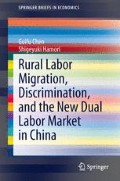Abstract
In this chapter, we provide new estimates for male–female hourly wage differentials in urban China on the basis of the Oaxaca and Reimers methods (Oaxaca 1973; Reimers 1983). We use the China Health and Nutrition Survey (CHNS) questionnaire (2004 and 2006 pooling data), and employ the Heckman two-step procedure in order to address the sample selection bias. The results indicate that the hourly wage differentials and the unexplained portion of the hourly wage differentials are smaller than the differentials obtained if the sample selection bias is ignored.
Access this chapter
Tax calculation will be finalised at checkout
Purchases are for personal use only
Notes
- 1.
Women’s Studies Institute of China (WSIC) (2006) indicated that in 1978, the average number of earning females in urban units was 83 % of that of males; however, it fell to 81.9 % in 2003.
- 2.
- 3.
The third part comprises differences between males selectivity bias and females selectivity bias (\( \hat{c}_{m} \bar{\lambda }_{m} - \hat{c}_{f} \bar{\lambda }_{f} \)); however, the number of males aged 16–60 doing housework (nonworking men) is only 28. Thus, we assume that the male selectivity bias is zero.
- 4.
- 5.
Source China Labour Statistical Yearbook 2006.
References
Arabsheibani GR, Lau L (1999) Mind the gap: an analysis of gender wage differentials in Russia. Labour 13:761–774
Blinder AS (1973) Wage discrimination: reduced form and structural estimates. J Hum Resour 8:436–455
Cai F, Du Y, Wang M (2005) How close is China to a labor market?. The Commercial Press, Beijing (in Chinese)
Gustafsson B, Li S (2000) Economic transformation and the gender earnings gap in urban China. J Popul Econ 13:305–329
Heckman JJ (1979) Sample selection bias as a specification error. Econometrica 47:153–161
Hughes J, Maurer-Fazio M (2002) Effects of marriage, education, and occupation on the female/male wage gap in China. Pacific Econ Rev 7:137–156
Liu W, Meng X, Zhang J (2000) Sectoral gender wage differential and discrimination in the transitional Chinese economy. J Popul Econ 13:331–352
Mason A, Scott R, Zhang L (2000) Gender wage gaps in post-reform rural China. CCAP’s Working Paper Series, No.WP-00-E25, Chinese Academy of Sciences
Meng X (1998) Male-female wage determination and gender wage discrimination in China’s rural industrial sector. Labour Econ 29:67–89
Meng X, Zhang J (2001) The two-tier labour market in urban China: occupational segregation and wage differential between urban residents and rural migrants in Shanghai. J Comp Econ 5:67–89
National Bureau of Statistics of China (2004, 2005 and 2006) China Statistical Yearbook. China Statistics Press, Beijing
Oaxaca RL (1973) Male-female wage differentials in urban labour markets. Int Econ Rev 14:693–709
Reimers CW (1983) Labor market discrimination against hispanic and black men. Rev Econ Stat 65:570–579
Wang F, Zuo X (1999) History’s largest labour flow: understanding China’s rural migration inside China’s cities: institutional barriers and opportunities for urban migrants. American Econ Rev, Papers and Proceedings 89:276–280
Women’s Studies Institute of China (WSIC) (2006) Report on Gender Equality and Women Development in China: 1995–2005, Social Sciences Academic Press (in Chinese)
Zhao Y (2000) Rural-to-urban labour migration in China: the past and the present. Rural Labour Flows in China. University of California Press, Berkeley, pp 15–33
Author information
Authors and Affiliations
Corresponding author
Rights and permissions
Copyright information
© 2014 The Author(s)
About this chapter
Cite this chapter
Chen, G., Hamori, S. (2014). An Empirical Analysis of Gender Wage Differentials in Urban China. In: Rural Labor Migration, Discrimination, and the New Dual Labor Market in China. SpringerBriefs in Economics. Springer, Berlin, Heidelberg. https://doi.org/10.1007/978-3-642-41109-0_5
Download citation
DOI: https://doi.org/10.1007/978-3-642-41109-0_5
Published:
Publisher Name: Springer, Berlin, Heidelberg
Print ISBN: 978-3-642-41108-3
Online ISBN: 978-3-642-41109-0
eBook Packages: Business and EconomicsEconomics and Finance (R0)

